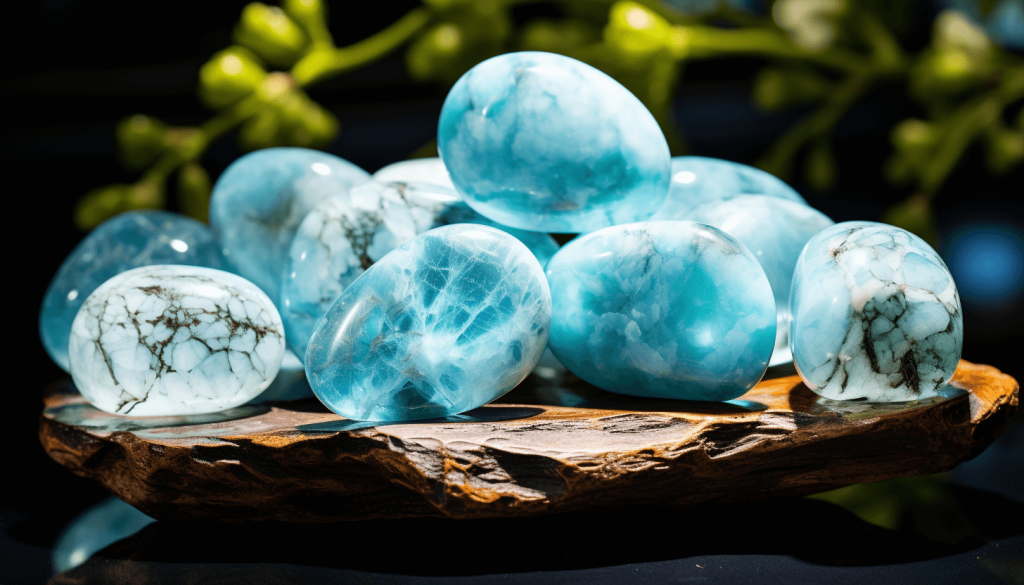Larimar, often referred to as the “Stone of the Caribbean,” is a captivating blue gemstone that mirrors the serene waters of its native region. Unlike the commonly known Agate, Larimar is exclusively found in the Dominican Republic, making it a unique and sought-after gem in the world of minerals and gemstones.
Origin and Geographical Distribution
With its mesmerizing blue hues reminiscent of the Caribbean Sea, Larimar has captivated the hearts of gem enthusiasts and jewelry lovers alike. This rare blue variety of the mineral pectolite is not only treasured for its aesthetic appeal but also for its intriguing origin story.
While many gemstones can be found in multiple locations around the world, Larimar’s geographical distribution is limited to a small mountainous region in the Dominican Republic. This exclusivity adds to its allure and value. The stone’s name is derived from a combination of “Larissa,” the name of the discoverer’s daughter, and “mar,” the Spanish word for sea, perfectly encapsulating the essence of this oceanic gem.
The journey of Larimar begins deep within the volcanic activities of the island. As hot gas bubbles rise through the volcanic chimneys, they mix with the surrounding minerals, leading to the formation of Larimar. Over time, erosion carries these stones from the mountains to the riverbeds, where they are eventually discovered and collected.
Given its limited geographical distribution and enchanting appearance, Larimar has become a symbol of the Dominican Republic, representing its rich natural heritage and the tranquil beauty of the Caribbean.
Formation of Larimar: Geological Processes behind the Stone
Larimar’s formation is a testament to the dynamic and intricate processes of our planet. The stone’s existence is a result of specific geological conditions that occurred millions of years ago. Let’s delve deeper into the fascinating journey of Larimar’s formation.
| Property | Description |
|---|---|
| Mineral Composition | Pectolite (with copper inclusions giving it the blue color) |
| Formation Process | Result of volcanic activity; formed when hot gases push crystallized minerals up through volcanic tubes |
| Color Variations | Range from light blue to deep blue, sometimes with white or red streaks due to secondary minerals |
| Hardness (Mohs Scale) | 4.5 – 5 |
| Transparency | Opaque to translucent |
| Luster | Silky to vitreous |
| Streak | White |
| Specific Gravity | 2.7 – 2.9 |
The formation of Larimar begins deep within the Earth’s crust. As magma from the mantle rises to the surface, it cools and solidifies, forming igneous rocks. Within these rocks, pockets of gas and minerals get trapped. Over time, as these pockets cool and crystallize, they form various minerals, including pectolite, the primary mineral of Larimar.
What sets Larimar apart from other pectolite minerals is the presence of copper. The copper inclusions are responsible for the stone’s distinctive blue hue. The varying shades of blue in Larimar are a result of the different concentrations and forms of copper present during its formation.
Over millions of years, erosion caused by rainfall washes these stones from their volcanic birthplace to riverbeds and eventually to the sea, where they are tumbled smooth before being deposited on beaches, ready to be discovered and cherished by those fortunate enough to come across them.
Healing Properties of Larimar: How the Stone Benefits Spiritual, Emotional, and Physical Wellness
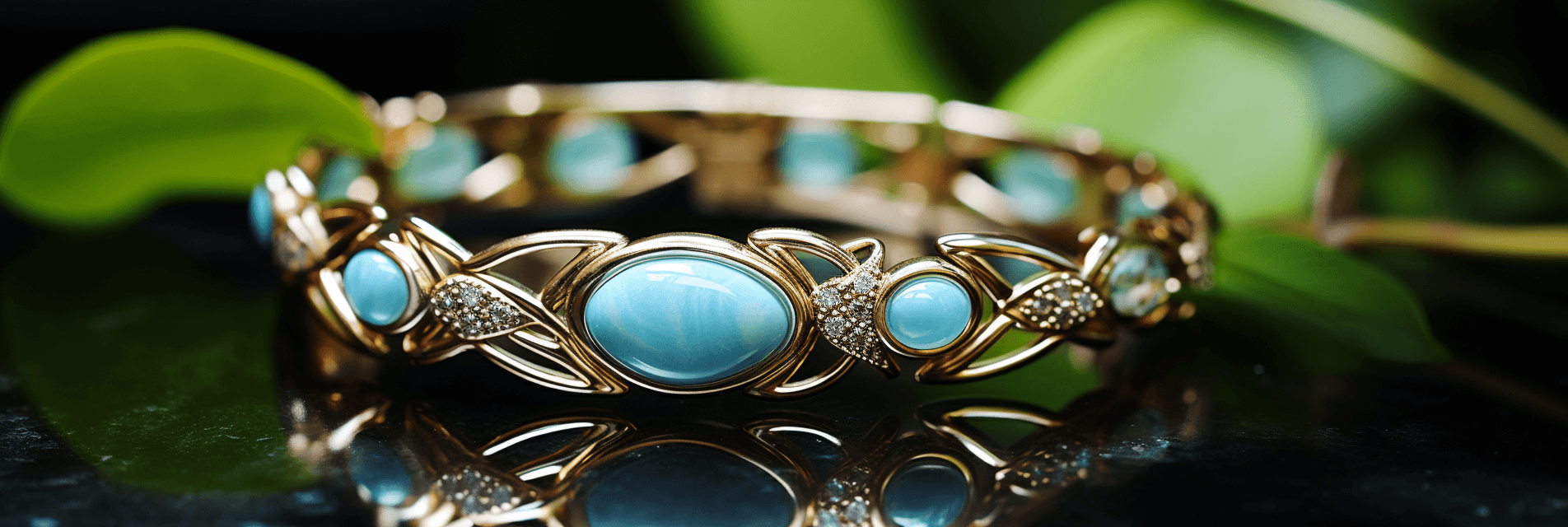
Larimar, often referred to as the “Stone of Atlantis” or the “Dolphin Stone,” is not just a visual delight but also a gem packed with profound healing energies. Its serene blue shades mirror the tranquil waters of the Caribbean, where it’s primarily found, and its energy is just as calming and soothing.
On a spiritual level, Larimar aids in breaking down the walls one has built around the heart for defense, and it opens the path to emotional release and clearing deep emotional patterns. Its vibrations can benefit the body, mind, and spirit in numerous ways.
Larimar is one of the few crystals that is associated with multiple elements – water, fire, and air. This makes it a powerful conduit for balancing different energies and promoting an inner sense of harmony.
Spiritual Healing
Larimar’s energy stimulates the heart, throat, third eye, and crown chakras, cultivating a sense of inner wisdom and outer manifestation. It aids in connecting with the divine feminine and accessing the goddess energies within. This stone is also known to enhance spiritual vision and enable contact with other realms and dimensions, especially the domain of Atlantis.
Emotional Healing
For those grappling with emotional wounds, Larimar offers solace and healing. It teaches respect, love, and nurturing for oneself, promoting self-confidence and constructive self-expression. The stone can also help to break ties from past traumas or relationships, allowing one to move forward with a heart ready to embrace the present and future.
Physical Healing
Physically, Larimar is believed to soothe and heal various ailments. It’s said to aid with cartilage and throat conditions, dissolve energy blockages in the chest, head, neck, and spine, and can also be beneficial for post-surgery recovery. Its cooling properties can help reduce inflammation and fever.
Resonance with the Throat Chakra
Larimar’s strong connection with the throat chakra makes it an excellent stone for singers, public speakers, and other individuals who use their voice in their profession. It aids in clear communication and helps its wearer to articulate emotions and boundaries with clarity and conviction.
Frequently Asked Questions
What is Larimar’s primary chakra?
Larimar primarily resonates with the throat chakra, aiding in clear communication and self-expression. However, it also stimulates the heart, third eye, and crown chakras, promoting emotional healing and spiritual insight.
How can Larimar assist in emotional healing?
Larimar helps in breaking down emotional walls, especially those built around the heart. It promotes self-love, respect, and nurturing, allowing for the release of negative emotions and patterns. The stone also aids in moving on from past traumas and relationships, fostering a sense of emotional freedom.
Larimar in Folklore and the Zodiac: Myths, Legends, and Astrological Connections of the Blue Stone
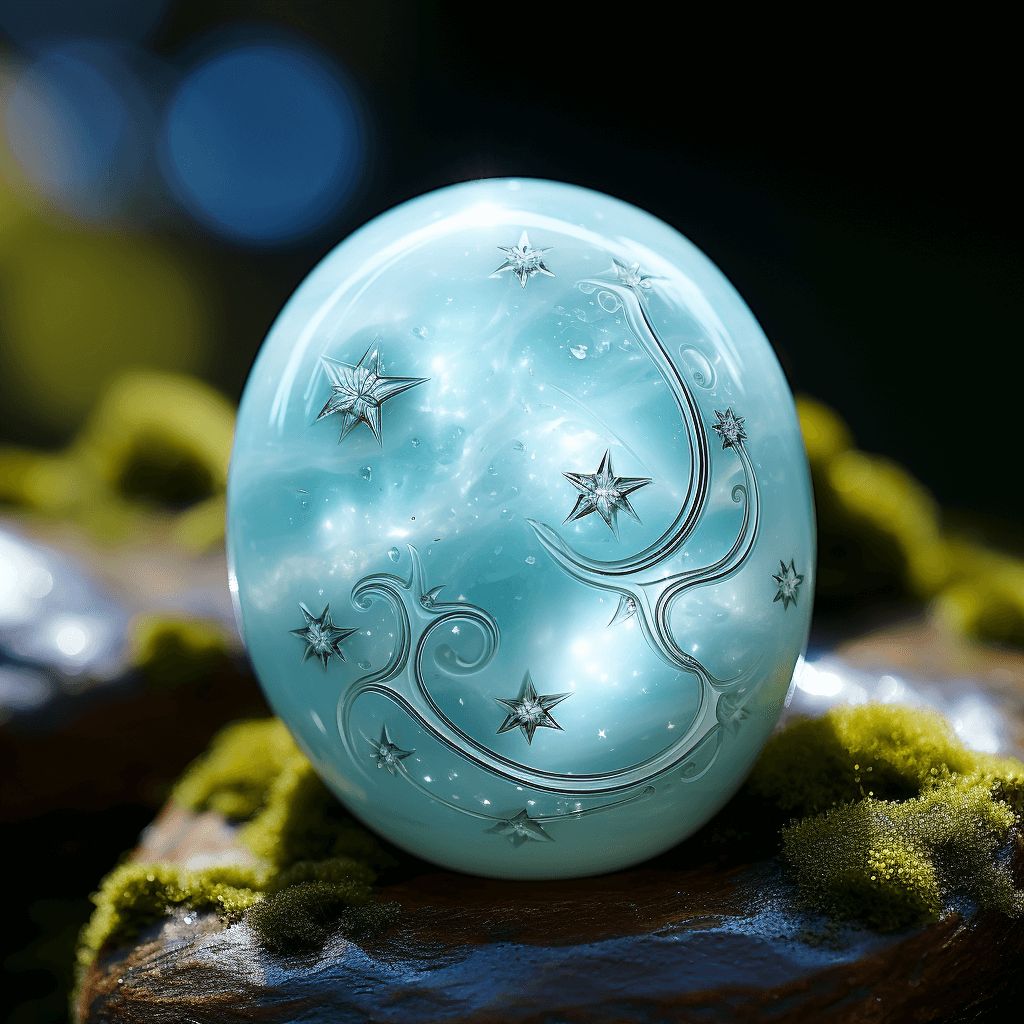
Larimar, with its ethereal blue hues reminiscent of the Caribbean Sea, has been a source of intrigue and admiration for many. Its unique appearance and rare occurrence have given rise to numerous myths, legends, and connections to the cosmos.
Myths and Legends
One of the most captivating legends surrounding Larimar is its association with the lost city of Atlantis. Some believe that the Dominican Republic, where Larimar is found, was a part of this ancient and technologically advanced civilization. The stone, with its oceanic patterns, is said to represent the sea around Atlantis and its spiritual energy.
Local tales in the Dominican Republic also speak of the stone as a gift from the sea. It’s believed that the sea, in its benevolence, washed these stones ashore for the people to discover and harness its calming energies.
The name “Larimar” is derived from a combination of the name “Larissa” (a woman whom the discoverer of the stone, Miguel Méndez, had met) and “Mar,” the Spanish word for sea. This name perfectly encapsulates the essence of the stone, which seems to capture the very soul of the sea.
Astrological Connections
In the realm of astrology, Larimar is often associated with the zodiac sign of Leo. Leos, ruled by the sun, can benefit from Larimar’s calming energies, balancing their fiery nature. The stone aids in tempering the ego, promoting humility, and encouraging clarity in communication – traits that can be particularly beneficial for the expressive and passionate Leo.
However, its soothing energies can be beneficial for all zodiac signs, especially those needing to enhance communication, embrace serenity, or connect deeper with their spiritual selves.
While Larimar is closely associated with Leo, many crystal healers also recommend it for Pisces. The water-like qualities of Larimar resonate well with this water sign, aiding in emotional balance and spiritual growth.
Larimar in Modern Therapy and Daily Life: From Jewelry and Meditation Tools to Crystal Healing Techniques
The captivating blue hues and serene energy of Larimar have made it a sought-after gemstone in various therapeutic and daily life applications. Beyond its aesthetic appeal, Larimar’s reputed healing properties have cemented its place in modern holistic practices.
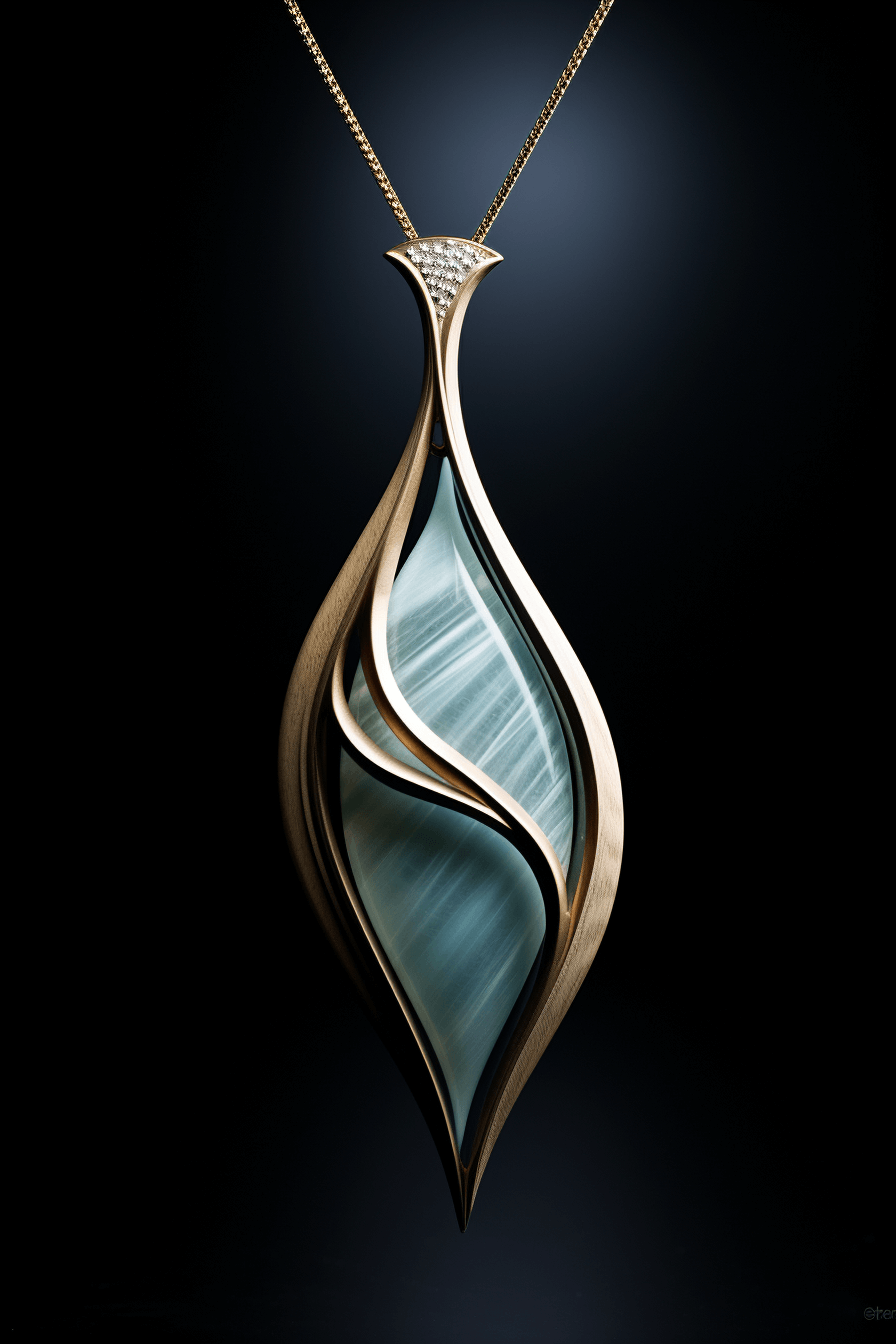
Jewelry and Adornments
Larimar’s stunning blue shades, often interspersed with white and turquoise patterns, make it a favorite choice for jewelry. Necklaces, earrings, rings, and bracelets featuring Larimar are not just fashion statements but also tools for wearers to carry its calming energies with them. The stone’s connection to the throat chakra makes it particularly popular for necklaces, lying close to the throat and supposedly aiding in clear communication.
Meditation and Spiritual Practices
For those on a spiritual journey, Larimar serves as a potent meditation tool. When held or placed nearby during meditation, it’s believed to enhance communication with higher realms, facilitate inner wisdom, and promote tranquility. Its resonance with the throat chakra aids in vocalizing thoughts and feelings, making it a valuable stone for those practicing vocal meditations or chants.
Crystal Healing Techniques
In the realm of crystal healing, Larimar is often used for its purported ability to balance water and fire energies within the body. Healers place the stone on the throat chakra to clear blockages, enhance communication, and promote emotional release. Its cooling energy is also said to help reduce inflammation, soothe skin disorders, and alleviate stress-related imbalances.
Everyday Practices
Even outside structured therapeutic or spiritual settings, many people integrate Larimar into their daily lives. Some keep a Larimar stone on their work desk to maintain a calm demeanor during stressful days. Others place it by their bedside, believing it promotes restful sleep and lucid dreaming. The stone’s serene energy is thought to permeate the environment, making spaces feel more peaceful and harmonious.
In essence, whether worn as jewelry, used in meditation, or simply kept close by, Larimar’s soothing energies and beautiful appearance make it a cherished stone in modern times.
Larimar’s Role in Art and Jewelry: Historical and Contemporary Significance
Larimar, with its ethereal blue hues reminiscent of the Caribbean Sea, has captured the imagination of artisans and jewelers for generations. Its unique appearance and limited geographical availability have made it a treasured gemstone in both historical and modern contexts.
Historical Significance
While Larimar’s global recognition is relatively recent, its allure is age-old. Indigenous tribes in the Dominican Republic, where Larimar is primarily found, regarded the stone as a gift from the sea. They believed it to be a piece of the sky that had fallen to Earth, and it played a role in their art and adornments. These early pieces, though rudimentary, showcased the stone’s natural beauty and set the stage for its later popularity.
Modern Jewelry and Art
In contemporary times, Larimar has become a staple in high-end jewelry collections. Its unique patterns, ranging from pure blue to intricate white and turquoise swirls, make each piece distinct. Jewelers often set Larimar in silver to complement its cool tones, though gold settings can offer a striking contrast.
Beyond jewelry, Larimar has found its way into various art forms. Sculptors, in particular, value the stone for its workability and vibrant color palette. Small statues, carvings, and even inlays in furniture or decorative items showcase Larimar’s versatility in the world of art.
Global Recognition
Though primarily sourced from the Dominican Republic, Larimar’s fame is global. Tourists visiting the Caribbean often seek Larimar jewelry as a unique keepsake. Its rarity outside the region makes it a prized possession in international markets. Recognized jewelry brands and designers have incorporated Larimar into their collections, further elevating its status in the gem world.
In conclusion, from ancient adornments to modern masterpieces, Larimar’s captivating appearance and unique origin story have solidified its place in the annals of art and jewelry. As appreciation for this gemstone continues to grow, so too will its legacy in the worlds of fashion, art, and culture.
Larimar Care and Maintenance: Ensuring the Longevity of Your Stone
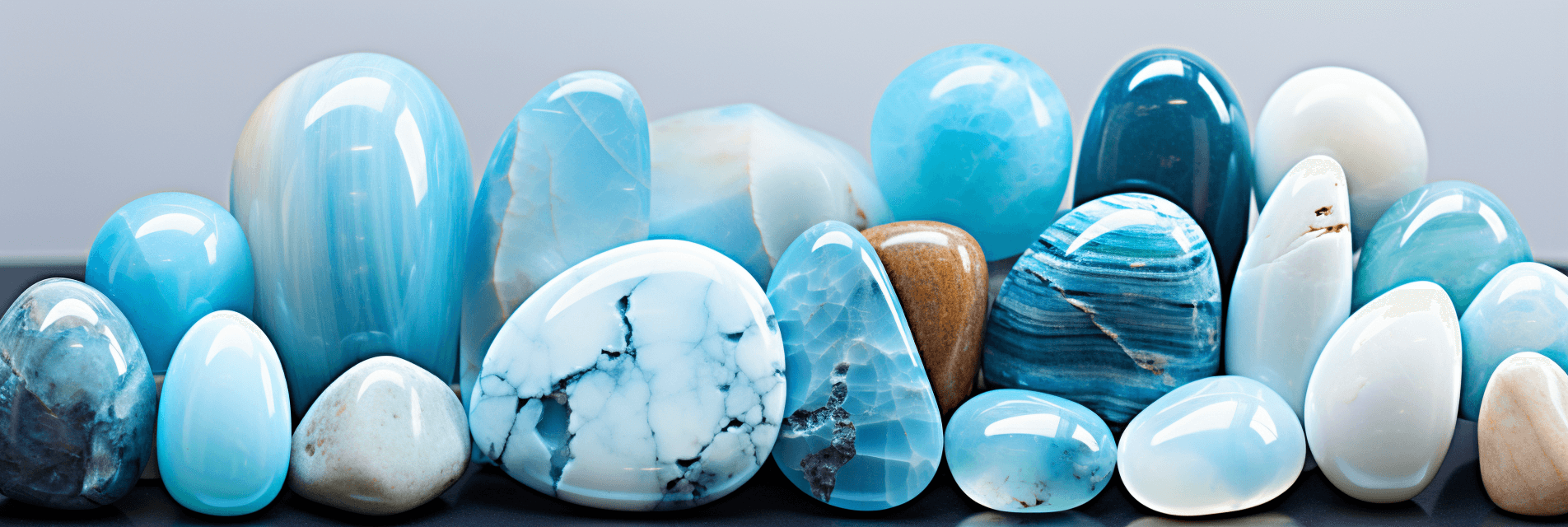
Larimar, with its mesmerizing blue hues, is not just a visual delight but also a gemstone that requires careful handling and maintenance. Ensuring its longevity means understanding its properties and knowing what to avoid. Here, we delve into the best practices for Larimar care and highlight some common mistakes to steer clear of.
Best Practices for Larimar Care
- Cleaning: Use lukewarm water, mild soap, and a soft cloth or brush to gently clean your Larimar. Avoid using harsh chemicals or ultrasonic cleaners.
- Storage: Store Larimar separately from other gemstones to prevent scratches. Using a soft pouch or a separate compartment in your jewelry box is ideal.
- Wearing: Put on your Larimar jewelry after applying makeup, perfume, or hairspray to prevent chemical damage.
- Temperature: Avoid exposing Larimar to extreme temperatures. Sudden temperature changes can cause the stone to crack.
What NOT to Do
- Avoid Harsh Chemicals: Chemicals in cleaning agents, chlorine in swimming pools, and even some cosmetics can damage Larimar’s surface.
- Don’t Wear During Strenuous Activities: Larimar can be scratched or chipped if knocked against hard surfaces.
- Avoid Direct Sunlight: Prolonged exposure to direct sunlight can cause Larimar to fade over time.
- Steer Clear of Ultrasonic Cleaners: These can cause internal fractures in the stone.
Frequently Asked Questions
Can you wear larimar everyday?
While Larimar is relatively durable, wearing it every day exposes it to potential damage from chemicals, scratches, and sunlight. It’s best to wear Larimar occasionally and follow the care guidelines mentioned above to ensure its longevity.
In essence, with the right care and attention, your Larimar gemstone can remain as captivating as the day you acquired it. By understanding its vulnerabilities and practicing preventive care, you can enjoy its beauty for years to come.
Larimar’s Global Market: Value, Rarity, and Demand
Larimar, often referred to as the “Caribbean gemstone,” has garnered significant attention in the global gem market. Its unique blue hues, reminiscent of the Caribbean seas, combined with its limited geographical availability, make it a sought-after gemstone. In this section, we’ll explore the value, rarity, and demand dynamics of Larimar in the global market.
Value of Larimar
The value of Larimar varies based on its color, clarity, and quality. Stones with a deep blue color, clear patterns, and fewer inclusions tend to fetch higher prices. Additionally, the craftsmanship of the jewelry piece and the weight of the Larimar used can also influence its price.
Rarity: A Gem from a Single Locale
Larimar’s rarity is primarily due to its limited geographical distribution. It is found only in a remote mountainous region of the Dominican Republic. This exclusivity has contributed to its high demand and, consequently, its value in the global market.
Demand Dynamics
Over the years, the demand for Larimar has seen a steady increase. Its unique appearance, combined with its limited availability, has made it popular among gem enthusiasts and collectors. Moreover, its metaphysical properties have also contributed to its rising demand in the holistic and spiritual communities.
Larimar is also known as the “Atlantis Stone” or “Dolphin Stone.” Legend has it that Larimar connects the wearer with the ancient civilization of Atlantis, promoting peace, clarity, and love.
In conclusion, Larimar’s unique characteristics, combined with its limited availability, have positioned it as a gemstone of significant value in the global market. As with all gemstones, its value is determined by a combination of factors, including its quality, rarity, and the demand-supply dynamics.
Counterfeits and Authenticity: How to Determine Genuine Larimar
With the rising popularity and demand for Larimar, it’s no surprise that the market has seen an influx of counterfeits. These imitations, often made from dyed materials or other blue stones, can be misleading for buyers. In this section, we’ll guide you through the steps to determine the authenticity of Larimar and how to distinguish genuine pieces from fakes.
Physical Characteristics
Genuine Larimar has a unique set of physical characteristics that can help in its identification:
- Color: Authentic Larimar ranges from white to light-blue, green-blue to deep blue. However, it does not come in a pure, intense blue. If the color seems too vibrant or uniform, it might be a red flag.
- Patterns: Larimar is known for its distinctive patterns, resembling the sun’s reflection on the Caribbean Sea. These patterns are often a mix of white, blue, and greenish streaks or patches.
- Texture: Genuine Larimar has a smooth texture but can have natural pits or inclusions. A too-perfect, bubble-like surface might indicate a resin or plastic imitation.
Heat Test
Being a stone, Larimar remains cold for a while even when exposed to direct sunlight or heat. In contrast, plastic or resin counterfeits will warm up quickly. However, this test should be done cautiously to avoid damaging the stone.
Price
If a deal seems too good to be true, it probably is. Authentic Larimar, given its rarity, comes at a price. Extremely cheap Larimar might be an indication of a counterfeit.
Reputable Sellers
Always buy Larimar from reputable dealers or jewelers who can provide provenance or certification for the stone. They should be able to answer questions about the stone’s origin and provide details about its quality.
Transparency Test
When placed against light, genuine Larimar will show some level of transparency, whereas most fakes will not.
In conclusion, while the allure of Larimar is undeniable, it’s essential to be equipped with the knowledge to differentiate between genuine Larimar and its counterfeits. By understanding its unique characteristics and being cautious about where and how you purchase, you can ensure that you’re getting an authentic piece of this beautiful gemstone.
Answering Common Questions about the Stone
In this section, we’ll address some of the most frequently asked questions about Larimar, providing concise and informative answers to help you better understand this captivating stone.
What is a Larimar stone good for?
Larimar is renowned for its healing properties, both physical and emotional. It’s believed to soothe tempers, alleviate fears, and promote a serene disposition. Spiritually, it’s associated with the throat chakra, aiding in clear communication and expression. Additionally, its captivating blue hue and unique patterns make it a sought-after gemstone for jewelry and adornments.
Is larimar an expensive stone?
Yes, genuine Larimar can be relatively expensive due to its rarity and the fact that it’s only found in the Dominican Republic. The price of Larimar varies based on its quality, color, clarity, and the intricacy of its patterns. Deep blue stones with intricate patterns are typically more valuable than lighter, less distinct pieces.
Why is larimar so rare?
Larimar is considered rare because it is only found in one location worldwide: the Dominican Republic. Its unique blue hue, combined with its limited geographic availability, makes it a highly sought-after gemstone.
How can you tell if larimar is real?
Authentic Larimar has a unique and intricate pattern of blues and whites, resembling the Caribbean Sea. Fake Larimar often lacks this intricate pattern. Additionally, genuine Larimar remains cool to the touch, unlike many imitations. When in doubt, it’s best to consult with a gemologist or purchase from reputable dealers.
Who should wear larimar?
Anyone can wear Larimar, especially those drawn to its calming energies and beautiful blue hues. It’s particularly beneficial for those seeking emotional healing, clarity in communication, or a connection to the sea.
What zodiac is Larimar stone?
Larimar is often associated with the zodiac sign of Leo due to its calming energies that can balance the fiery nature of Leos. However, anyone, regardless of their zodiac sign, can benefit from Larimar’s properties.
Is Larimar a lucky stone?
Many believe Larimar to be a stone of serenity, clarity, and healing, which can bring about good fortune and positivity to its wearer. Its calming energies can help in making clear decisions, potentially leading to positive outcomes.
Can Larimar go in the sun?
It’s advisable to avoid prolonged exposure of Larimar to direct sunlight. The sun’s rays can fade its vibrant blue color over time.
What month is larimar?
Larimar is not officially designated as a birthstone for any specific month. However, its blue hue often associates it with water and the summer months.
What is the best Colour of larimar?
The most prized color of Larimar is a deep blue, reminiscent of the Caribbean Sea. However, Larimar can range from white to light blue to green-blue to deep blue. The value increases with the depth and vibrancy of the blue, combined with intricate patterns.
Can you sleep with larimar?
Yes, many people choose to sleep with Larimar under their pillow or on their nightstand to benefit from its calming energies and promote peaceful sleep.
Is Larimar good for anxiety?
Many crystal enthusiasts and healers believe that Larimar’s calming energies can help alleviate anxiety, stress, and other negative emotions. Its connection to the throat chakra also aids in clear communication, which can be therapeutic for those with anxiety.
Does Larimar break easily?
Larimar has a Mohs hardness of around 4.5 to 5, which means it’s relatively soft compared to many other gemstones. It can be prone to scratches and breakage if not handled with care. It’s essential to treat Larimar jewelry and stones gently to ensure their longevity.
These are just a couple of the many questions people have about Larimar. As with any gemstone, it’s essential to do thorough research and consult with experts when considering a purchase or seeking in-depth information.

